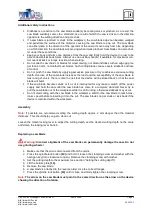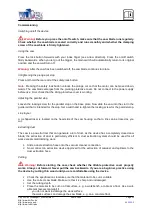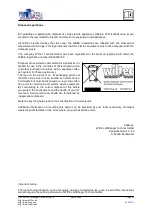
possibly work with a delay due to damaged parts as well as deposits of debris and foreign ob -
jects.
Make sure that the bottom plate of the saw does not shift during the plunge process if the set-
ting of the cutting angle is not 90°. If the saw blade shifts to the side, it will jam and the device
may kick back.
Make sure that the guard covers the saw blade before placing the saw on the table or floor. A
saw blade that runs out unprotected causes the saw to move backwards and cut into
everything in its path. You should know how long it takes for the blade to come to a complete
standstill after you have let go of the switch.
Saw blade replacement and safety
The protective device provided with the tool must be securely attached to the power tool so
that as little of the saw blade as possible protrudes. The protective device shields the operator
from flying splinters of a broken saw blade and from accidental contact with the saw blade.
Use only bonded, reinforced or diamond-coated saw blades for your saw. The mere fact that
an accessory can be attached to your power tool does not mean that it is safe to use.
The nominal speed of the accessories must be at least equal to the maximum speed specified
on the power tool. Accessories running faster than their rated speed can break and be thrown
around.
Saw blades in general
Saw blades may only be used for the recommended applications. For example, they must not
be used for grinding. Lateral forces exerted on a saw blade can cause the blade to crack.
Always use undamaged saw blade flanges that have the correct diameter for the selected saw
blade. Correct flanges support the saw blade, thus reducing the risk of the blade breaking.
Do not use worn, reinforced saw blades from larger power tools. Saw blades designed for a
larger power tool are not suitable for the higher speed of a smaller tool and can break.
The outside diameter and density of your accessories must be within the performance range
of the saw. Unsuitable accessories cannot be adequately protected or controlled.
The size of the mandrel of the saw blade and the flange must match the spindle of the saw.
Flanges with holes that do not mate with the power tool fasteners can become unbalanced,
run irregularly and might cause loss of control of the saw.
Do not use damaged saw blades. Check the blades for debris and cracks before each use. If
the saw or a saw blade is dropped, inspect it for damage or attach an undamaged blade. After
checking and attaching the saw blade, move the device to a safe position for the saw and
bystanders and let it run for one minute at the highest idle speed. Damaged saw blades usu-
ally break during this test period.
Wear protective clothing. Depending on the work to be performed, wear full face protection,
safety goggles or safety glasses. It is also recommended to wear a dust mask, hearing protec -
tion and safety gloves. The protective goggles must be able to keep foreign bodies away from
the various possible uses of the device. The dust mask should be able to filter out particles
arising during work. Exposure to excessive noise for too long can damage your hearing.
Keep the power cord away from rotating parts. If you lose control, the power cord could be cut
or caught, causing your hand or arm to get caught in the saw blade.
Never operate the saw while you are carrying it. Accidental contact can result in parts of your
clothing getting caught in the moving parts of the machine and being pulled into the saw
blade.
Regularly clean the ventilation system of the saw. The motor fan allows dust to get into the
housing. Too much dust build-up can cause the fan to clog and create electrical hazards.
Do not use accessories that require liquid coolant. Using water or other liquid coolants could
result in electric shock.
© by WilTec Wildanger Technik GmbH
Item 62554
Page 8
http://www.WilTec.de
http://www.aoyue.eu
04 2021
-1































